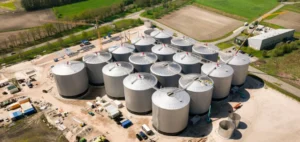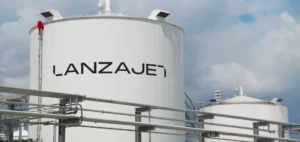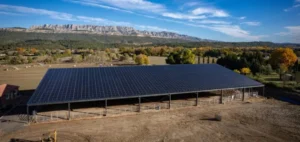2030, the energy storage market will explode.
A Wood Mackenzie study published on September 30 predicts significant growth in the energy storage market over the next decade.
The author estimates a compound annual growth rate (CAGR) of 31% over the next few years, reaching a storage capacity of 741 GWh in 2030.
70% of storage will be upstream of the meter, i.e. before reaching individual buildings for end use.
Worldwide installed capacity is expected to grow by 3.3% a year between 2020 and 2030.
It stood at 171 GW in 2019, and Prescient & Strategic Intelligence forecasts that it will reach 241 GW in 2030. 
USA and China lead the storage market
According to Wood Mackenzie’s report, the USA will continue to lead the energy storage market until 2030.
It will have 365 GWh of storage capacity on its territory in 2030, i.e. 49% of the world’s total capacity.
This deployment is being driven by utilities, which are positioning themselves to meet green energy targets in the various states.
China ranks second in this market, with a share of 21% of global capacity in 2030 on their territory, or 153 GWh.
China is asking solar and wind companies to offset the costs of integrating their electricity into the grid, which is encouraging the development of storage systems.
Growth in Europe will be slower, and the European market will remain dominated by Great Britain and Germany.
Growth is expected in France and Italy, with Spain and the rest of Europe to follow with the help of the European Commission.
Growth drivers in the storage market
Two main challenges are driving the rapid, large-scale deployment of energy storage solutions: integrating intermittent renewable electricity into power grids, and ensuring energy security in developing countries.
Facilitating the market penetration of renewable energies
The development of energy storage facilities is an integral part of the energy transition.
The integration of intermittent renewable energies requires the ability to store surplus electricity produced during periods of strong sunshine or high winds, to compensate for low production at night or when there is no wind.
Ensuring the permanent balance of the distribution network is the major challenge to be met to ensure the penetration of renewable energies in the global energy mix.
To integrate solar and wind power and compete with fossil fuels, we need to be able to store energy for longer and at lower cost than is currently the case.
“Storage is the key to strong renewable energy growth. The question is whether storage can capture stable long-term revenue streams. Lower cost, longer duration storage can enable intermittent renewables to overtake coal, gas and pumped hydro, enabling higher levels of solar and wind penetration.”
Wood Mackenzie Senior Analyst Le Xu
Ensuring network stability in Asia-Pacific and Africa
Asia-Pacific will remain one of the biggest markets for energy storage in the years to come.
Local governments are seeking to ensure the stability of distribution networks and avoid recurrent blackouts and blackouts.
In addition, the deployment of new infrastructures and the electrification of isolated areas are creating the need for on-site storage systems.
Green” economic stimulus to boost the market
During the COVID-19 pandemic, the shutdown of industrial activities and a general slowdown in production in China slowed the supply of storage system components worldwide.
In 2020, deployment of energy storage solutions fell by 17%, or 2 GWh less than in 2019.
Despite this, stakeholders and investors – individuals and large groups – continue to invest in this market.
Even if some investments are postponed, the overall trajectory led by the need to store renewable electricity is undisturbed.
The storage market is expected to recover by spring 2021.
The market is also expected to benefit from the “green” economic stimulus introduced by several nations in response to the health crisis.
The current question is whether storage can generate long-term profitability.
Extensive deployment of stationary batteries
In 2019, mechanical storage is the most developed type of storage worldwide.
It enables high-power currents to be restored using natural resources, making it economically viable.
However, significant growth is expected in the electrochemical storage category with the development of stationary batteries.
Growth in the lithium battery market
The battery storage market was valued at $19 billion in 2019.
According to an analysis published on Global Market Insights, total installed capacity in 2030 could be 74 GW at a CAGR of 17.6% over the next decade.
The United States, the European Union and Asia-Pacific currently hold 85% of the world’s stationary storage battery capacity, and the biggest players are BYD, Toshiba Corporation, Tesla and Panasonic Corporation.  The predicted CAGR for Lithium-Ion batteries is 20% between 2020 and 2030.
The predicted CAGR for Lithium-Ion batteries is 20% between 2020 and 2030.
LFP (Lithium Iron Phosphate) batteries are also expected to develop, and could account for 30% of the battery market in 2030, compared with just 10% in 2015.
These batteries will overtake NMC (Nickel Manganese Cobalt) batteries on the market.
Lithium batteries not only store electricity, but also regulate the frequency for better grid integration.
What’s more, they enable cold starting, i.e. restoring power to a network without using external transmission lines.
Innovations announced by Elon Musk
On September 23, Elon Musk announced several technological advances made by the Tesla group, including some in batteries.
They have succeeded in removing cobalt, the extraction of which is highly controversial, from their batteries.
They have also removed graphite from the anodes of lithium batteries, replacing it with a polymer.
If these advances materialize on a commercial level, it would be another step towards the large-scale deployment of storage batteries.






















